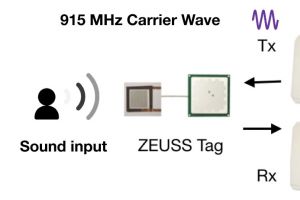Physical surfaces and objects enhanced with acoustic sensing and communication capabilities provide an opportunity for an unprecedented understanding of human behavior as well as novel ways of interaction and environmental control. Combined with the advances in material science and additive manufacturing techniques, we attempt to "weave" acoustic sensing and computational capabilities into everyday objects. ZEUSSS or Zero Energy Ubiquitous Sound Sensing Surface allows physical objects and surfaces to be instrumented with a thin, self-sustainable material, giving rise to revolutionary applications such as interactive walls, localization of sound sources and people, surveillance via audio, contextualization and safer authentication services.
The ZEUSSS patch is prototyped using flexible electronic components - a thin microphone built upon the principles of triboelectric nanogenerator, a flexible antenna and a transistor. The current setup consists of an RF transmitter and receiver, and ZEUSSS patch placed on any curved or flat surface. The transmitter broadcasts a carrier RF wave, which is received and amplitude-modulated by the ZEUSSS patch in the presence of slight vibrations like speech or touch. This signal is backscattered to the receiver and the audio information captured by the patch is extracted.
ZEUSSS is the very first example of a completely self-powered vibrational sensing and data collection solution based on the combination of TENG an analog-backscatter communication. Such an architecture can be further expanded for passive sensing and communication of many different mechanical forces and vibrations in our environment, which promises to open doors for new applications in interactions, control, and contextual sensing domain.
Reference:
1. SATURN: A Thin and Flexible Self-powered Microphone Leveraging Triboelectric Nanogenerator
2. ZEUSSS: Zero Energy Ubiquitous Sound Sensing Surface Leveraging Triboelectric Nanogenerator and Analog Backscatter Communication
We are interested in ubiquitous computing and the research issues involved in building and evaluating ubicomp applications and services that impact our lives. Much of our work is situated in settings of everyday activity, such as the classroom, the office and the home. Our research focuses on several topics including, automated capture and access to live experiences, context-aware computing, applications and services in the home, natural interaction, software architecture, technology policy, security and privacy issues, and technology for individuals with special needs.



